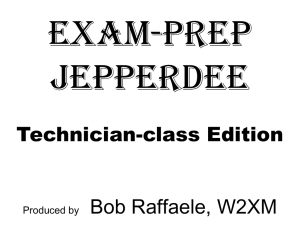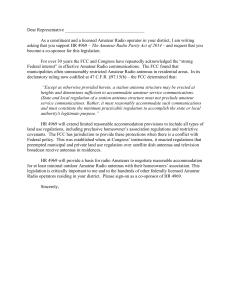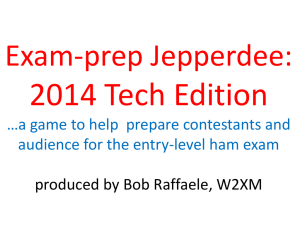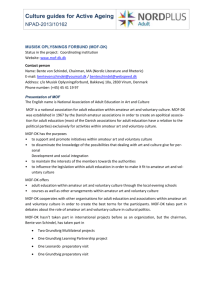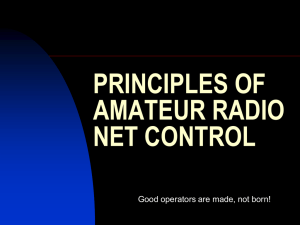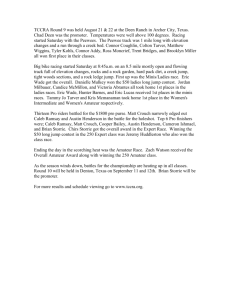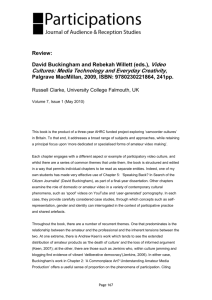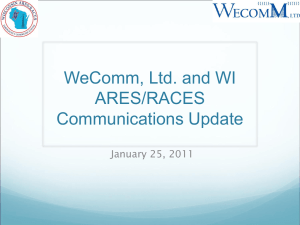Subelement E1 - Commission's Rules
advertisement
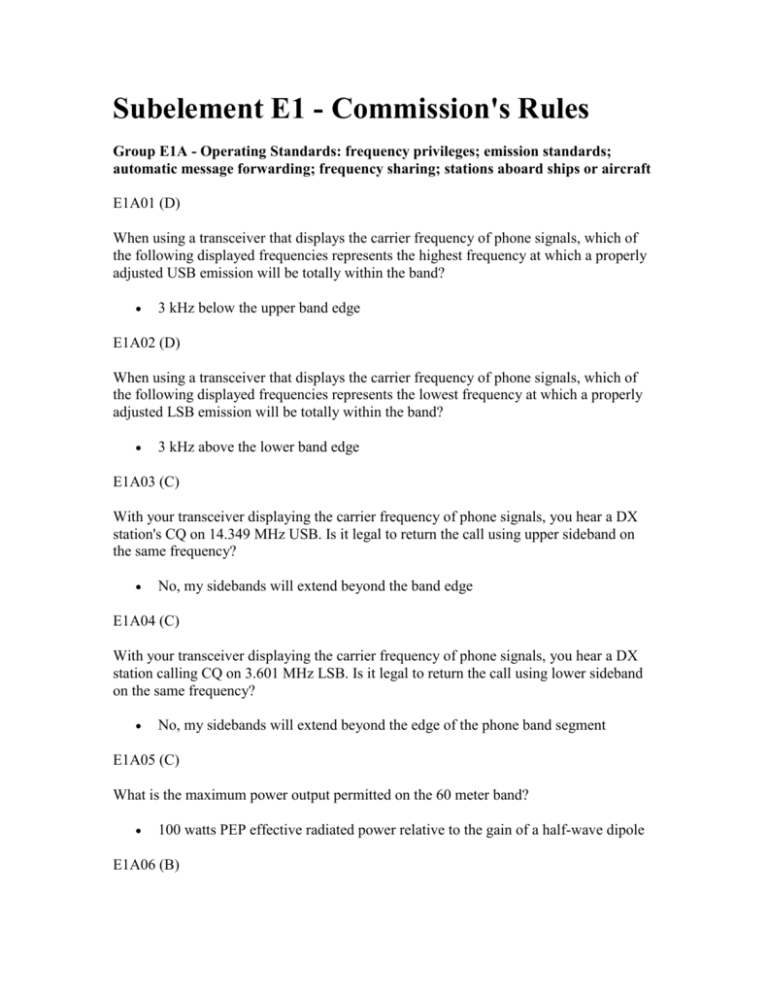
Subelement E1 - Commission's Rules Group E1A - Operating Standards: frequency privileges; emission standards; automatic message forwarding; frequency sharing; stations aboard ships or aircraft E1A01 (D) When using a transceiver that displays the carrier frequency of phone signals, which of the following displayed frequencies represents the highest frequency at which a properly adjusted USB emission will be totally within the band? 3 kHz below the upper band edge E1A02 (D) When using a transceiver that displays the carrier frequency of phone signals, which of the following displayed frequencies represents the lowest frequency at which a properly adjusted LSB emission will be totally within the band? 3 kHz above the lower band edge E1A03 (C) With your transceiver displaying the carrier frequency of phone signals, you hear a DX station's CQ on 14.349 MHz USB. Is it legal to return the call using upper sideband on the same frequency? No, my sidebands will extend beyond the band edge E1A04 (C) With your transceiver displaying the carrier frequency of phone signals, you hear a DX station calling CQ on 3.601 MHz LSB. Is it legal to return the call using lower sideband on the same frequency? No, my sidebands will extend beyond the edge of the phone band segment E1A05 (C) What is the maximum power output permitted on the 60 meter band? 100 watts PEP effective radiated power relative to the gain of a half-wave dipole E1A06 (B) Which of the following describes the rules for operation on the 60 meter band? Operation is restricted to specific emission types and specific channels E1A07 (D) What is the only amateur band where transmission on specific channels rather than a range of frequencies is permitted? 60 meter band E1A08 (B) If a station in a message forwarding system inadvertently forwards a message that is in violation of FCC rules, who is primarily accountable for the rules violation? The control operator of the originating station E1A09 (A) What is the first action you should take if your digital message forwarding station inadvertently forwards a communication that violates FCC rules? Discontinue forwarding the communication as soon as you become aware of it E1A10 (A) If an amateur station is installed aboard a ship or aircraft, what condition must be met before the station is operated? Its operation must be approved by the master of the ship or the pilot in command of the aircraft E1A11 (B) What authorization or licensing is required when operating an amateur station aboard a US-registered vessel in international waters? Any FCC-issued amateur license or a reciprocal permit for an alien amateur licensee E1A12 (C) With your transceiver displaying the carrier frequency of CW signals, you hear a DX station's CQ on 3.500 MHz. Is it legal to return the call using CW on the same frequency? No, sidebands from the CW signal will be out of the band. E1A13 (B) Who must be in physical control of the station apparatus of an amateur station aboard any vessel or craft that is documented or registered in the United States? Any person holding an FCC-issued amateur license or who is authorized for alien reciprocal operation Group E1B - Station restrictions and special operations: restrictions on station location; general operating restrictions, spurious emissions, control operator reimbursement; antenna structure restrictions; RACES operations E1B01 (D) Which of the following constitutes a spurious emission? An emission outside its necessary bandwidth that can be reduced or eliminated without affecting the information transmitted E1B02 (D) Which of the following factors might cause the physical location of an amateur station apparatus or antenna structure to be restricted? The location is of environmental importance or significant in American history, architecture, or culture E1B03 (A) Within what distance must an amateur station protect an FCC monitoring facility from harmful interference? 1 mile E1B04 (C) What must be done before placing an amateur station within an officially designated wilderness area or wildlife preserve, or an area listed in the National Register of Historical Places? An Environmental Assessment must be submitted to the FCC E1B05 (D) What is the maximum bandwidth for a data emission on 60 meters? 2.8 kHz E1B06 (A) Which of the following additional rules apply if you are installing an amateur station antenna at a site at or near a public use airport? You may have to notify the Federal Aviation Administration and register it with the FCC as required by Part 17 of FCC rules E1B07 (B) Where must the carrier frequency of a CW signal be set to comply with FCC rules for 60 meter operation? At the center frequency of the channel E1B08 (D) What limitations may the FCC place on an amateur station if its signal causes interference to domestic broadcast reception, assuming that the receiver(s) involved are of good engineering design? The amateur station must avoid transmitting during certain hours on frequencies that cause the interference E1B09 (C) Which amateur stations may be operated in RACES? Any FCC-licensed amateur station certified by the responsible civil defense organization for the area served E1B10 (A) What frequencies are authorized to an amateur station participating in RACES? All amateur service frequencies authorized to the control operator E1B11 (A) What is the permitted mean power of any spurious emission relative to the mean power of the fundamental emission from a station transmitter or external RF amplifier installed after January 1, 2003, and transmitting on a frequency below 30 MHZ? At least 43 dB below E1B12 (B) What is the highest modulation index permitted at the highest modulation frequency for angle modulation? 1.0 Group E1C - Station control: definitions and restrictions pertaining to local, automatic and remote control operation; control operator responsibilities for remote and automatically controlled stations E1C01 (D) What is a remotely controlled station? A station controlled indirectly through a control link E1C02 (A) What is meant by automatic control of a station? The use of devices and procedures for control so that the control operator does not have to be present at a control point E1C03 (B) How do the control operator responsibilities of a station under automatic control differ from one under local control? Under automatic control the control operator is not required to be present at the control point E1C04 (B) When may an automatically controlled station retransmit third party communications? Only when transmitting RTTY or data emissions E1C05 (A) When may an automatically controlled station originate third party communications? Never E1C06 (C) Which of the following statements concerning remotely controlled amateur stations is true? A control operator must be present at the control point E1C07 (C) What is meant by local control? Direct manipulation of the transmitter by a control operator E1C08 (B) What is the maximum permissible duration of a remotely controlled station's transmissions if its control link malfunctions? 3 minutes E1C09 (D) Which of these frequencies are available for an automatically controlled repeater operating below 30 MHz? 29.500 - 29.700 MHz E1C10 (B) What types of amateur stations may automatically retransmit the radio signals of other amateur stations? Only auxiliary, repeater or space stations Group E1D - Amateur Satellite service: definitions and purpose; license requirements for space stations; available frequencies and bands; telecommand and telemetry operations; restrictions, and special provisions; notification requirements E1D01 (A) What is the definition of the term telemetry? One-way transmission of measurements at a distance from the measuring instrument E1D02 (C) What is the amateur satellite service? A radio communications service using amateur radio stations on satellites E1D03 (B) What is a telecommand station in the amateur satellite service? An amateur station that transmits communications to initiate, modify or terminate functions of a space station E1D04 (A) What is an Earth station in the amateur satellite service? An amateur station within 50 km of the Earth's surface intended for communications with amateur stations by means of objects in space E1D05 (C) What class of licensee is authorized to be the control operator of a space station? All classes E1D06 (A) Which of the following special provisions must a space station incorporate in order to comply with space station requirements? The space station must be capable of terminating transmissions by telecommand when directed by the FCC E1D07 (A) Which amateur service HF bands have frequencies authorized to space stations? Only 40m, 20m, 17m, 15m, 12m and 10m E1D08 (D) Which VHF amateur service bands have frequencies available for space stations? 2 meters E1D10 (B) Which amateur stations are eligible to be telecommand stations? Any amateur station so designated by the space station licensee, subject to the privileges of the class of operator license held by the control operator E1D11 (D) Which amateur stations are eligible to operate as Earth stations? Any amateur station, subject to the privileges of the class of operator license held by the control operator Group E1E - Volunteer examiner program: definitions, qualifications, preparation and administration of exams; accreditation; question pools; documentation requirements E1E01 (D) What is the minimum number of qualified VEs required to administer an Element 4 amateur operator license examination? 3 E1E02 (C) Where are the questions for all written US amateur license examinations listed? In a question pool maintained by all the VECs E1E03 (C) What is a Volunteer Examiner Coordinator? An organization that has entered into an agreement with the FCC to coordinate amateur operator license examinations E1E04 (D) Which of the following best describes the Volunteer Examiner accreditation process? The procedure by which a VEC confirms that the VE applicant meets FCC requirements to serve as an examiner E1E05 (B) What is the minimum passing score on amateur operator license examinations? Minimum passing score of 74% E1E06 (C) Who is responsible for the proper conduct and necessary supervision during an amateur operator license examination session? Each administering VE E1E07 (B) What should a VE do if a candidate fails to comply with the examiner's instructions during an amateur operator license examination? Immediately terminate the candidate's examination E1E08 (C) To which of the following examinees may a VE not administer an examination? Relatives of the VE as listed in the FCC rules E1E09 (A) What may be the penalty for a VE who fraudulently administers or certifies an examination? Revocation of the VE's amateur station license grant and the suspension of the VE's amateur operator license grant E1E10 (C) What must the administering VEs do after the administration of a successful examination for an amateur operator license? They must submit the application document to the coordinating VEC according to the coordinating VEC instructions E1E11 (B) What must the VE team do if an examinee scores a passing grade on all examination elements needed for an upgrade or new license? Three VEs must certify that the examinee is qualified for the license grant and that they have complied with the administering VE requirements E1E12 (A) What must the VE team do with the application form if the examinee does not pass the exam? Return the application document to the examinee E1E13 (A) What are the consequences of failing to appear for re-administration of an examination when so directed by the FCC? The licensee's license will be cancelled E1E14 (A) For which types of out-of-pocket expenses do the Part 97 rules state that VEs and VECs may be reimbursed? Preparing, processing, administering and coordinating an examination for an amateur radio license Group E1F - Miscellaneous rules: external RF power amplifiers; national quiet zone; business communications; compensated communications; spread spectrum; auxiliary stations; reciprocal operating privileges; IARP and CEPT licenses; third party communications with for E1F01 (B) On what frequencies are spread spectrum transmissions permitted? Only on amateur frequencies above 222 MHz E1F02 (A) Which of the following operating arrangements allows an FCC-licensed US citizen to operate in many European countries, and alien amateurs from many European countries to operate in the US? CEPT agreement E1F03 (A) Under what circumstances may a dealer sell an external RF power amplifier capable of operation below 144 MHz if it has not been granted FCC certification? It was purchased in used condition from an amateur operator and is sold to another amateur operator for use at that operator's station E1F04 (A) Which of the following geographic descriptions approximately describes "Line A"? A line roughly parallel to and south of the US-Canadian border E1F05 (D) Amateur stations may not transmit in which of the following frequency segments if they are located in the contiguous 48 states and north of Line A? 420 - 430 MHz E1F06 (C) What is the National Radio Quiet Zone? An area surrounding the National Radio Astronomy Observatory E1F07 (D) When may an amateur station send a message to a business? When neither the amateur nor his or her employer has a pecuniary interest in the communications E1F08 (A) Which of the following types of amateur station communications are prohibited? Communications transmitted for hire or material compensation, except as otherwise provided in the rules E1F09 (D) Which of the following conditions apply when transmitting spread spectrum emission? All of these choices are correct E1F10 (C) What is the maximum transmitter power for an amateur station transmitting spread spectrum communications? 10 W E1F11 (D) Which of the following best describes one of the standards that must be met by an external RF power amplifier if it is to qualify for a grant of FCC certification? It must satisfy the FCC's spurious emission standards when operated at the lesser of 1500 watts, or its full output power E1F12 (B) Who may be the control operator of an auxiliary station? Only Technician, General, Advanced or Amateur Extra Class operators E1F13 (C) What types of communications may be transmitted to amateur stations in foreign countries? Communications incidental to the purpose of the amateur service and remarks of a personal nature E1F14 (A) Under what circumstances might the FCC issue a "Special Temporary Authority" (STA) to an amateur station? To provide for experimental amateur communications
